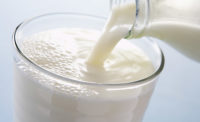
Good Study Habits
by Lynn Petrak
The latest dairy research brings a wellspring of
positive nutrition and weight control news.
“Diet” is one of those words with more than one meaning, connoting either a weight-loss plan or the overall intake of food and beverages.
For many years, research involving dairy products was
focused on the latter, as scientists sought to confirm that dairy foods and
beverages are rich in nutrients key to health and well-being. Lately,
several studies have also covered the former interpretation of the term,
determining that the consumption of certain dairy products helps speed
weight loss and ensure weight maintenance.
That’s heartening news for those in the industry
who have had to adopt a somewhat defensive posture in the past two decades,
as various sources have slammed the consumption of animal-based proteins in
the “good vs. bad” food debate. Thanks to more sophisticated
research methods and tools and a more knowledgeable and open audience, the
polar-opposite viewpoints have largely given way to a more moderate
philosophy backed by leading-edge science.
The body of scientific work, as it really relates to
the human body itself, includes a plethora of studies related to both
weight control and the prevention of disease through nutrition. At any
given time, research projects are underway at universities and private
laboratories around the country, conducted by independent scientists and
researchers and sometimes called for or sponsored by industry
organizations.
It is, to be sure, a dynamic time for those doing
— and using — the research. “A lot of good things are
happening in nutrition right now,” says Michael Zemel, Ph.D.,
professor of nutrition and medical science and director of the Nutrition
Institute at the University of Tennessee, and a lead researcher on
groundbreaking studies linking dairy intake with weight loss. “One
the one hand, we have more molecular tools than we’ve had before, but
we don’t have the old reductionist philosophy. Instead, we understand
that there is a web of interactions, and we are more attuned to study that
web using sophisticated technology to be sure.”
Gregory Miller, Ph.D., executive vice president of
science and innovation for the Rosemont, Ill.-based National Dairy Council
arm of Dairy Management Inc. (DMI), agrees that there is a certain sense of
enlightenment right now. “This is exciting for the field of
nutrition,” he says. “It’s a whole new area of nutrition
and healthy eating that we are looking at.”
Weighty Issues
Much of the buzz surrounding the latest scientific
research has centered on the discovery that the consumption of certain
types of dairy products can help aid weight loss or enhance weight control
due to an efficient burning of calories and fat, among other factors.
Zemel has spearheaded significant and much-quoted
studies tied to dairy consumption and weight loss. One of his most recent
projects was designed to support and extend previous studies from the past
few years and involved a pair of clinical trials involving obese
African-American adults. Published in the journal Obesity Research last fall, the
latest study showed that consuming three servings of dairy every day
resulted in a marked increase in weight loss on a reduced-calorie eating
plan.
Even without dieting, three serving of dairy led to
weight loss and an increase in lean body mass among Zemel’s study
subjects. “After 24 weeks we found that participants eating three
daily servings of dairy preserved lean mass, which includes muscle, while
losing about twice as much weight and fat compared to those eating one
daily serving,” he reports.
According to Zemel, the findings are that much more
important because the goal of the original research study was not tied to
weight loss. “Certainly, my own hypothesis was more nutrient based,
focused more on calcium research,” he says of his initial studies
that determined dairy intake can lead to more efficient weight loss and
control. “It’s very encouraging, and it’s really tied
into body composition. It takes you to a healthier body.”
Currently, Zemel and his researchers are in the lab
working to expand the base findings even further. “We have extended
our observations and said, ‘If our previous mechanisms are true, then
there ought to be components of dairy, based on molecular signaling, that
may have an antioxidant effect,’” he says. “No one talks
about antioxidants in proteins, but it turns our there are very important
effects on oxidation.”
Meanwhile, another recent weight-control study of note
was published last year in the American Journal
of Clinical Nutrition and led by
professionals at Purdue University. Researchers there conducted a clinical
trial that found women burned more fat and calories after a meal when their
diets included three to four servings of dairy a day.
Like Zemel’s work, the objective of the Purdue
study was not necessarily to spur weight loss but investigate the mechanism
by which dairy and calcium impact body composition through the body’s
ability to burn fat and use calories. “From the results of this
study, we put together a rough calculation based on the increased fat
burned from a meal that suggests a high-dairy diet followed over a year
could potentially result in the loss of 10 pounds of fat a year,”
says Dorothy Teegarden, Ph.D., lead investigator and professor of nutrition
at Purdue.
For its part, the National Dairy Council through DMI
is facilitating several studies that explore the ways in which dairy
consumption affects body composition. Earlier this spring, for instance,
DMI shared results of a scientific review that showed whey protein, derived
from dairy and high in essential amino acids, is effective in muscle
building and maintenance. “We are focused on a couple of different
areas, such as how the consumption of whey protein works to build lean body
mass in young active adults,” Miller says. “We are also trying
preliminary work related to the elderly, putting a call out for research
projects related to the way the elderly lose muscle mass, and how whey
could potentially prevent that loss.”
In another project linked to its “3-A-Day”
promotional and educational program, DMI has initiated a large clinical
trial to demonstrate the benefits of three servings of dairy a day.
“It’s in progress right now, and we are trying to show the
benefits of 3-A-Day that enhance the ability to reduce weight and lose fat,
particularly around the abdomen,” Miller reports.
Beyond studies showing milk’s effectiveness in
weight loss, other new research debunks the myth that eating or drinking
dairy products leads to weight gain.
Findings published in the American
Journal of Clinical Nutrition recently
showed that calcium intake was not associated with weight gain in men over
a 12-year period. The study included more than 19,000 healthy men aged 40
to 75 who were enrolled in the Health Professionals Follow Up Study, a
long-ranging, influential project.
Scientific research doesn’t exist in a vacuum, of
course, and to that end, the industry and individual processors take
advantage of the recent findings and convey the positive weight loss news
to consumers. For its part, the MilkPEP campaign, from the International
Dairy Foods Association (IDFA), Washington, D.C., recently launched a
“Celebrate Success” integrated marketing program that shares
inspirational stories from women who have excelled in losing weight by
drinking 24 ounces of milk each day, cutting calories and exercising. The
campaign includes in-store point-of-sale materials, television advertising,
magazine advertising and Spanish-language materials, along with a
partnership with Curves fitness centers.
Dairy manufacturers, too, are using information on
weight loss and dairy foods in their own materials and marketing efforts,
from on-package labeling to website features. Dean Foods, for instance, has
included an “Add Dairy, Lose Weight” section to its Web site,
as do many other national and regional brands.
To Their Health
In addition to studies focused on weight loss, several
recent research projects have reinforced the important nutritional role
that dairy products play in the human diet. That dairy foods can be deemed
good for you is not new, but the latest scientific projects are newsworthy
in their discovery.
“There are many things related to showing the
nutrient packaging of dairy, that it’s much more valuable than
calcium alone to bone health and other aspects,” Miller says.
“That is the next step in research funding.”
For example, Zemel’s study of African-American
adults pointed to other health benefits to dairy in addition to weight
loss. For one thing, subjects who consumed more dairy than the group
without dairy experienced significant decreases in blood pressure and
insulin levels. The findings hence suggested that there may be an
association between dairy intake and reduced risk for hypertension and
symptoms of Type II diabetes.
Several other studies are geared to discovering the
specific health effects of dairy products. Just a few weeks ago, IDFA
touted results from a new Canadian project showing that women who rarely
drank milk during their pregnancy gave birth to smaller babies compared to
women who drank more milk. Featured in the Canadian
Medical Association Journal, the research
suggested that drinking the recommended amount of three 8-ounce glasses of
milk a day may increase babies’ birth weight and noted that vitamin D
such as that found in milk not only affects an infant’s bone
formation but also the development of the brain, immune function and
susceptibility to chronic disease later in life.
Another recently released scientific study by
researchers at Purdue University determined that active women who use oral
contraceptives may help stave off bone loss and eventual osteoporosis by
consuming dairy foods and beverages. The authors, including Teegarden, note
that using oral contraceptives could reduce the risk of osteoporosis by
three to 10 percent over a year with the simultaneous intake of dairy
foods.
Consumption of certain dairy foods has been shown to
prevent other types of health problems as well. A study published in the American Journal of Clinical Nutrition last year indicated that increased intake of lowfat dairy
foods as part of an overall recommended Dietary Approaches to Stop
Hypertension (DASH) eating plan may lower blood pressure more effectively
than a conventional lowfat diet. (Developed by the National Heart, Lung and
Blood Institute, the DASH plan calls for three daily servings of lowfat
dairy foods and eight to 10 daily serving so fruit and vegetables.)
In addition to improving health or preventing certain
conditions, research is also ongoing that addresses wellness and fitness
among active, fit adults. For example, a study conducted by researchers at
Indiana University and published earlier this year in the International Journal of Sport Nutrition and Exercise
Metabolism reported that athletes who drank
chocolate milk after a rigorous exercise routine were able to do so longer
and with more stamina during a second workout, compared to athletes who
consumed commercial sports beverages.
Fortified Front
Another area of research that has emerged in recent
years involves ingredients used to enhance the nutritional profile of foods
and beverages. More products today, including dairy items, are fortified
with added nutrients.
At times, research on fortification and product
development go hand in hand. Stonyfield Farms, New Londonderry, N.H., for
instance, uses a new specially enriched form of inulin in its organic
yogurt, which has been shown in clinical trials to boost calcium absorption
at low use levels. According to spokeswoman Carmelle Druchniak, Stonyfield
keeps close tabs on the latest nutrition research through its staff
nutritionist. “A lot of times she brings things to our attention,
like a new study showing inulin can reduce cholesterol or how the daily
intake of el redeuri can reduce gastrointestinal illness,” Druchniak
says.
Dairy-derived ingredients are a component of many
fortified products. With the research showing the health and weight loss
benefits of whey protein, for example, that ingredient is becoming more
popular as a source of fortification. “There are yogurt products that
use whey protein as an ingredient and it is being used in protein bars and
drinks,” Miller says. “Hopefully, it will be used in more
non-traditional products as well.”
Zemel, too, says that whey protein and other
dairy-based ingredients may become part of more food product formulations.
“I think it will cause a second or third look at whey proteins as a
food ingredient that adds value to manufactured foods,” he says.
Interestingly enough, the expansion of the body of
scientific research is leading not only to the addition of certain
dairy-based components in other foods, but to the viewpoint that dairy
products are fortified foods of and by themselves. “I think
functional foods will be a growing field, and so they should be, but I
think we have to reconceptualize what a functional food is,” Zemel
says. “Can a glass of milk be moved from being thought of as a
commodity to being a functional food? I think so.”
Lynn Petrak is a freelance journalist based in the
Chicago area.
CHEESE: TO YOUR HEALTH
Health and
wellness opportunities abound for cheese, according to a presentation at
the recent International Cheese Technology Exposition.
Four key wellness areas exist for cheese, according to
Dean Sommer of the Wisconsin Center for Dairy Research: lowfat cheeses,
probiotics, fortification and health positioning.
Apart from cheese specifically designed or positioned
as lowfat products, cheeses naturally possess varying fat contents, Sommer
noted to the audience in Madison, Wis. “We see opportunities to
expand that even further,” he said.
Because taste is such a key factor for
consumers’ acceptance of foods, the future of lowfat and fat-free
cheeses is more promising for ingredients rather than table cheese, Sommer
said, describing research in this area for Swiss, romano and cheddar flavor
profiles.
Additionally, research is showing that live cultures
can survive the manufacturing and aging processes to make cheese a good
delivery vehicle for probiotics, Sommer reported. And while up to now,
consumer acceptance of probiotics in the United States has paled in
comparison to that in Europe, “some of us believe the tide is
turning,” he said.
Sommer suggested probiotics could be added to string
cheese, which is popular with children, or cottage cheese.
Meanwhile, cheese could be fortified with added
vitamin D, as is milk; made with milk containing enhanced levels of the
cancer-fighting fatty acid CLA; or spiked with omega 3, with which Sommer
acknowledged there could be flavor issues due to its origins in fish.
“I think the opportunities will come to
pass,” Sommer said. “We need to reach out and grab them.”
$OMN_arttitle="Good Study Habits";?>

